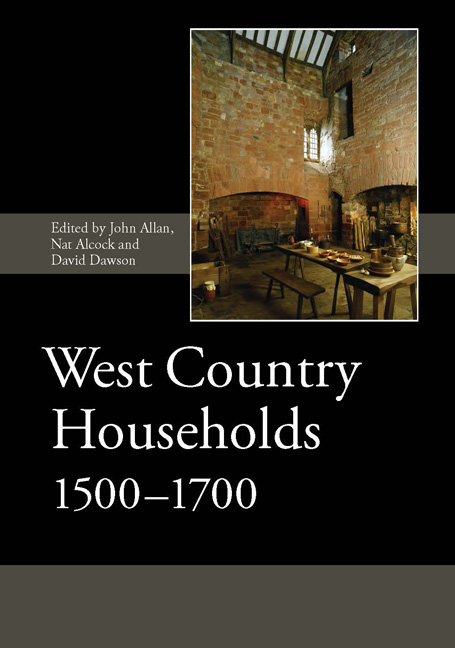Book contents
- Frontmatter
- Dedication
- Contents
- List of Illustrations
- List of Contributors
- List of Abbreviations
- Introduction
- I The Form and Development of West Country Houses
- 1 The Development of the Vernacular House in South-West England, 1500–1700
- 2 The Transformation of the Building Stock of Exeter, 1450–1700
- 3 The Appearances of Godolphin, Cornwall, c. 1300–c. 1630
- 4 Boiling Furnaces, Smoking Chambers and Malt Kilns in West Country Households
- II The Decoration of West Country Houses
- III The Material Culture of West Country Households
- Index of People and Places
- Index of Subjects
1 - The Development of the Vernacular House in South-West England, 1500–1700
from I - The Form and Development of West Country Houses
Published online by Cambridge University Press: 05 May 2015
- Frontmatter
- Dedication
- Contents
- List of Illustrations
- List of Contributors
- List of Abbreviations
- Introduction
- I The Form and Development of West Country Houses
- 1 The Development of the Vernacular House in South-West England, 1500–1700
- 2 The Transformation of the Building Stock of Exeter, 1450–1700
- 3 The Appearances of Godolphin, Cornwall, c. 1300–c. 1630
- 4 Boiling Furnaces, Smoking Chambers and Malt Kilns in West Country Households
- II The Decoration of West Country Houses
- III The Material Culture of West Country Households
- Index of People and Places
- Index of Subjects
Summary
This paper offers a review of current understanding of the ways in which the West Country house developed between the late medieval period and the end of the 17th century. Its central focus is in Devon, where the writer's principal research interests have lain, but it also discusses developments in Somerset and Cornwall.
INTRODUCTION
In 1647, Robert Herrick, the poet and vicar of Dean Prior, Devon, published a poem entitled ‘A Thanksgiving to God for his House’, part of which reads:
Lord thou has given me a cell
Wherein to dwell;
An little house, whose humble Roof
Is weather-proof
under the sparres of which I lie
Both soft, and dry
Low is my porch, as is my Fate,
Both void of State;
And yet the threshold of my door
Is worn by th' poor
Who thither come, and freely get
Good words, or meat;
Likeas my Parlour, so my Hall
And kitchin's small;
A little Butterie, and therein
A little Byn
Which keeps my little loafe of Bread
unchipt, unflead;
Some brittle sticks of Thorne or Briar
Make me a fire
Close by whose living coals I sit
And glow like it.
In 1646, Herrick, a Royalist, had been replaced at Dean Prior by a Presbyterian minister, so this poem, published a year later, looked back to the calm before the storm of the Civil War had swept over Devon. His nostalgia has given us a perfect penpicture of a Devon house, with its chamber under the thatch and rafters (spars), a low porch, small parlour, hall, kitchen and buttery, with a fire of thorn burning in the hall. This paper explores the realities that lie behind his description, and especially how the character of houses in South-West England diversified from the great uniformity of the medieval period up to the end of the 17th century. It concentrates on Devon, since this is where the author's experience mainly lies; many Somerset houses share the character of Devon ones, though with a wider range of walling materials.
- Type
- Chapter
- Information
- West Country Households, 1500–1700 , pp. 9 - 34Publisher: Boydell & BrewerPrint publication year: 2015



